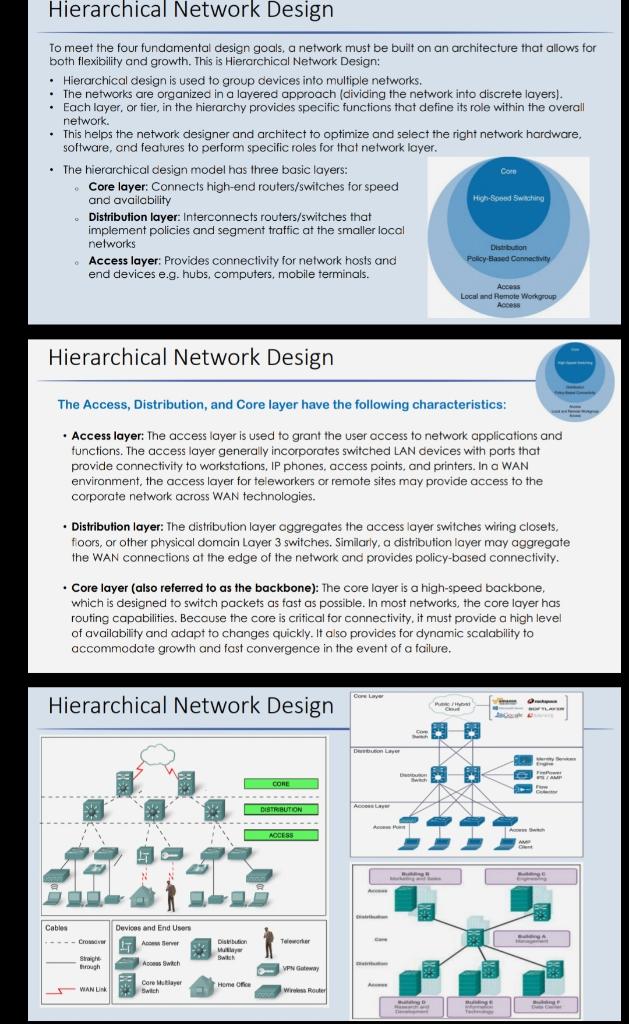Answered step by step
Verified Expert Solution
Question
1 Approved Answer
How do I match the characteristics of the hierachal model and the Cisco Enterprise Architecture to their correct location as shown in the map above?



How do I match the characteristics of the hierachal model and the Cisco Enterprise Architecture to their correct location as shown in the map above? Please help, thank you.
Modular Hierarchical Network Design Some network architecture further divides the 3-layer hierarchical design into modular areas. The modules represent areas that have different physical or logical connectivity. This modularity enables flexibility in network design and better facilitates implementation and troubleshooting. Three areas of focus in modular hierarchical network design are as follows: Enterprise campus: This area contains the network elements required for independent operation within a single campus or branch location. This is where the building access, building distribution, and campus core are located. Server farm: A component of the enterprise campus, the data center server farm protects the server resources and provides redundant, reliable high-speed connectivity. Enterprise edge: As traffic comes into the campus network, this area filters traffic from the external resources and routes it into the enterprise network. It contains all the elements required for efficient and secure communication between the enterprise campus and remote locations, remote users, and the Internet. Modular Hierarchical Network Design Cisco Enterprise Architectures Enterprise Edge E-Commerce Enterprise Campus Building Access WAN and Internet ISPA Building Distribution Internet Connectivity Enterprise Branch ISPB Campus Core BE TX WAN and Metro Ethernet Site-to-Site VPN Enterprise Teleworker Frame Relay ATMMetro Ethernet... Server Farm and Data Center Remote Access and VPN PSTN Network Management Modular Hierarchical Network Design The modular approach has the following design advantages: It creates a deterministic network with clearly defined boundaries between modules. This provides clear demarcation points so that the network designer knows exactly where the traffic originates and where it flows. It eases the design task by making each module independent. The designer can focus on the needs of each area separately. It provides scalability by allowing enterprises to add modules easily. As network complexity grows, the designer can add new functional modules. It enables the designer to add services and solutions without changing the underlying network design. Hierarchical Network Design To meet the four fundamental design goals, a network must be built on an architecture that allows for both flexibility and growth. This is Hierarchical Network Design: Hierarchical design is used to group devices into multiple networks. The networks are organized in a layered approach (dividing the network into discrete layers). Each layer, or tier, in the hierarchy provides specific functions that define its role within the overall network This helps the network designer and architect to optimize and select the right network hardware. software, and features to perform specific roles for that network layer. The hierarchical design model has three basic layers: Com Core layer: Connects high-end routers/switches for speed and availability High-Speed Switching Distribution layer: Interconnects routers/switches that implement policies and segment traffic at the smaller local networks Distribution Access layer: Provides connectivity for network hosts and Policy Based Connectivity end devices e.g. hubs, computers, mobile terminals. Access Local and Remote Workgroup Access 0 Hierarchical Network Design The Access, Distribution, and Core layer have the following characteristics: Access layer: The access layer is used to grant the user access to network applications and functions. The access layer generally incorporates switched LAN devices with ports that provide connectivity to workstations, IP phones, access points, and printers. In a WAN environment, the access layer for teleworkers or remote sites may provide access to the corporate network across WAN technologies. Distribution layer: The distribution layer aggregates the access layer switches wiring closets, foors, or other physical domain Layer 3 switches. Similarly, a distribution layer may aggregate the WAN connections at the edge of the network and provides policy-based connectivity, . Core layer (also referred to as the backbone): The core layer is a high-speed backbone, which is designed to switch packets as fast as possible. In most networks, the core layer has routing capabilities. Because the core is critical for connectivity, it must provide a high level of availability and adapt to changes quickly. It also provides for dynamic scalability to accommodate growth and fast convergence in the event of a failure. Core Layer Hierarchical Network Design CORE DISTRIBUTION Aadi NOCESS Cables Devices and End Users Acorder ---- CROWN Terower Distribution M Sre through Ao Switch VPN Gateway WANUN Care Mayer Such Home Office wel In this interactive activity, you match the characteristics of the hierarchal model and the Cisco Enterprise Architecture to their correct locationStep by Step Solution
There are 3 Steps involved in it
Step: 1

Get Instant Access to Expert-Tailored Solutions
See step-by-step solutions with expert insights and AI powered tools for academic success
Step: 2

Step: 3

Ace Your Homework with AI
Get the answers you need in no time with our AI-driven, step-by-step assistance
Get Started


